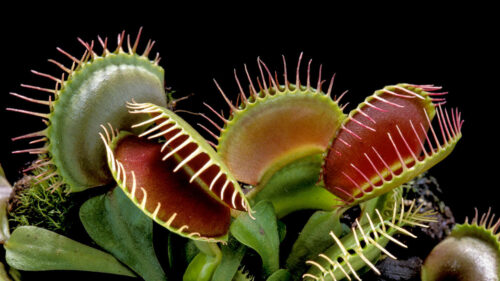

1. dexterous (adj)
having the ability to perform a difficult action quickly and skillfully with the hands
2. snare (v)
to get or achieve something that is difficult to get
3. stray (v)
to travel along a route that was not originally intended, or to move outside a limited area
4. genomes (n)
the complete set of genetic material of a human, animal, plant or other living things
5. shuffling (v)
to move similar things from one position or place to another, often to give an appearance of activity when nothing useful is being done
How Venus flytraps evolved their taste for meat

How does a plant develop a taste for flesh? In the play Little Shop of Horrors, all it takes is a drop of human blood. But in real life, it takes much more. Now, a study of three closely related carnivorous plants suggests dexterous genetic shuffling helped them evolve the ability to catch and digest protein-rich meals.
Carnivorous plants have developed many devious ways to snare prey. Pitcher plants, for example, use “pitfall traps” that contain enzymes for digesting stray insects. The sundew rolls up its sticky landing pad when mosquitoes get caught. And the Venus flytrap uses modified leaves, or pads, that snap shut when an insect lands—but only after the pads sense multiple touches on their trigger hairs.
To find out how these traps evolved, researchers led by computational evolutionary biologist Jörg Schultz and plant biologist Rainer Hedrich, both of the University of Würzburg, sequenced the genomes of the sundew, the aquatic waterwheel, and the Venus flytrap, which are all closely related. They then compared their genomes with those of nine other plants, including a carnivorous pitcher plant and noncarnivorous beetroot and papaya plants.
They found that the key to the evolution of meat eating in this part of the plant kingdom was the duplication of the entire genome in a common ancestor that lived about 60 million years ago, the team reports today in Current Biology. That duplication freed up copies of genes once used in roots, leaves, and sensory systems to detect and digest prey.
But Luis Herrera-Estrella, a plant geneticist at Texas Tech University, is pleased to know about the new genes that are now linked to carnivory. He and others can study how genes were rewired to make meat eating possible. Indeed, Hedrich says, it seems most plants already have many of the necessary genes. “The path to carnivory seems to be open for all plants.”
Resource: https://www.sciencemag.org/news/2020/05/how-venus-flytraps-evolved-their-taste-meat

- What did scientists compare the genomes of carnivorous plants to?
- What kind of leaves did the article say Venus fly traps have?
- What happens to the leaves of the sundew plant?
- Who is Rainer Hedrich?
“Revenge is a dish best served unexpectedly and from a distance - like a thrown trifle.”
Frances Hardinge







